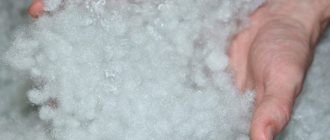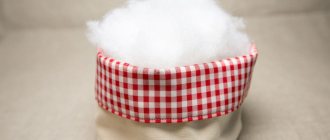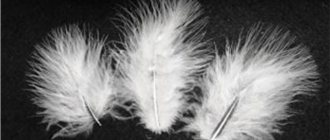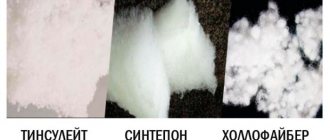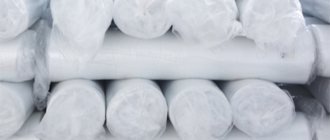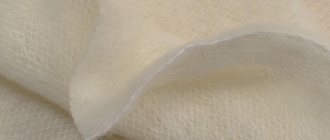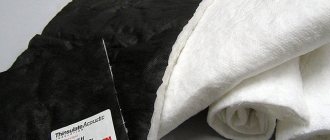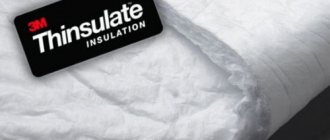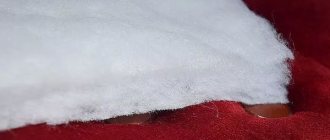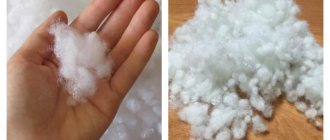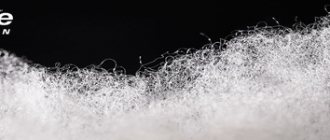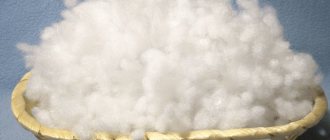For a long time, the leader in the insulation market was synthetic winterizer, which is still used today. But technologies for the production of warm clothing are developing - in recent years, many different materials have appeared that have their own distinctive nuances, pros and cons. Thinsulate and holofiber are among the practical new products. To decide which filler is better, consider their history, characteristics, scope of application and care features.
Thinsulate
Thinsulate insulation was originally developed for NASA spacesuits. But a few years later, the general public learned about it, and the material began to be used in sportswear. For the first time, for “civilian” purposes, it was used in equipment for skiers and clothing for researchers of the Far North. Only in the 2000s did he gain real popularity. Now Thinsulate is everywhere: in coats, blankets, shoes and even toys.
Advantages of Thinsulate
This is a synthetic non-woven material. It is made from hundreds of thousands of ultra-fine fibers combined into one fabric. That is why it will keep its shape even after being in a vacuum bag.
- Thermal insulation. Due to its structure, the material acts as an excellent insulator. You won't be cold as it will retain your body heat and provide extra warmth. But therein lies the danger: you can overheat in warm weather. Therefore, there is no need to wrap yourself in Thinsulate if it’s +20 outside!
- Ease. The insulation fibers are thinner than human hair. Therefore, even despite the density, the material remains quite light and thin.
- Elasticity. The fiber can take on any shape, which is convenient for athletes, as it provides complete freedom of movement.
- Safety. The material is not flammable; even when in contact with an open fire, it does not burn out, but only melts. Thinsulate is also completely hypoallergenic.
- Versatility. It can be used in any area of human life.
- Moisture resistance. Thinsulate does not accumulate moisture and does not absorb water.
- Wear resistance. The filler does not lose its original properties even after several years of active use.
- Ease of care. The main thing is not to wash it in boiling water.
We have NASA astronauts to thank for all this. Just think how often they could change things on the orbital station? That’s why the insulation has collected all the coolest things that could be gotten from it. If Thinsulate could withstand temperatures of -273°C, then Russians -40°C simply do not care for it.
Disadvantages of Thinsulate
Despite all the coolness of the material, it also has its drawbacks. But they cannot be compared with the advantages and now you will understand why.
- High cost of material. You have to pay for quality.
- May cause overheating. This is only possible if you wear things with Thinsulate in warm weather (when the temperature is above +15°C).
- Accumulates static electricity. Long-haired girls will need to check their hairstyle more carefully.
- Difficult to paint. But since it is located inside the fabric, this does not play a special role.
Thinsulate care
- The material does not require special care. You only need to follow a few basic rules:
- Washing should be done in warm or cold water;
- After washing, Thinsulate must be rinsed several times;
- Laundry liquids should be used instead of powders;
- You need to let things dry naturally.
Comparisons and differences of materials
Despite the similarity of synthetic insulation, there are some features, knowing which you can more easily determine your preferences when choosing a specific product:
- The most important difference is the price . Thinsulate is much more expensive, about 4 times, due to the unique complex production technology, and, therefore, products made from it are higher in price.
- Holofiber, due to its lower cost, has a wider range of applications , has soundproofing properties, and is used for the production of various filters and acoustic devices.
- Due to the difference in the structures of the materials, one of them is more voluminous, as a result, down jackets and children's clothes with holofiber will take up more space in the closet. For the same insulation of a product, “synthetic down” only needs a thickness of 3-4 mm .
- For the same reason, Thinsulate is more often used for professional athletes, it allows you to move freely and wear tighter clothes, and in serious competitions every little detail is important.
- Holofiber is actively used for the manufacture of blankets, pillows, and furniture, as it is initially produced in a variety of forms.
- Thinsulate can withstand extremely low temperatures and has been used to produce specialized clothing for astronauts.
- The care scheme for products made from materials is similar, it involves cleaning in cool water , machine washing is acceptable, however, jackets with “synthetic balls” can be subjected to intensive washing and bleaching without fear of loss of properties.
- You need to be careful with clothes with tisulate, since prolonged wear and an increase in external temperature can cause overheating of the body .
- The above material can accumulate static electricity, which is not very convenient for girls with long hair.
Holofiber
This is another one of the most popular insulation materials. Its structure is similar to a canvas consisting of hollow spirals. They become the insulating layer. The material is homogeneous and at the same time porous.
Production
The raw material used here is a polyester compound processed by the temperature bonding method. After processing, it is passed through a special wind tunnel, where the fibers are soldered into a web using high temperature.
Properties of holofiber
Thanks to a special production method, holofiber has a number of features:
- Strength. The holofiber filler is almost impossible to tear, since the fibers welded under the influence of temperature are incredibly dense.
- Environmentally friendly. Holofiber simply does not contain glue.
- Biological stability. Holofiber does not decompose and does not rot.
- Heat capacity and air tightness. You will not freeze even in the most severe cold, but you will not be haunted by the greenhouse effect during the transition season.
- Elasticity. Anything made from holofiber will return to its shape in a few minutes, even if it has been stored for several weeks in vacuum packaging.
- Soundproofing. It practically does not allow sound to pass through.
- Cheapness. Due to the availability of raw materials, holofiber is a fairly cheap insulation material.
The many faces of polyester
Most modern insulation is made from synthetic polyester fiber - polyester. The process of its production is quite lengthy and multi-stage. Sometimes when making fiber, not only synthetic threads are used, but also natural ones (wool, cotton).
In order for the insulation to better retain heat and trap heated air, it is made as porous and airy as possible. This effect is achieved in several ways - polyester fibers are hollow inside, and their shape is usually spiral, which allows additional heat to be retained between the turns of the fibers. Due to special processing of the threads, they do not lose their shape, do not cake, or form lumps. This means that the service life of products with this filler is quite long.
Polyester is produced by industrial enterprises in different countries, and each of them issues a patent for its own name and manufacturing technology. As a result, there are many polyester fiber-based products available on the insulation market. Each of them differs slightly from analogues in internal structure and properties, but has a similar composition.
Polyester fibers are used not only as insulation for winter clothing. They fill pillows and use them to make blankets. After special processing, polyester is used in weaving - the material can consist entirely or partially of synthetics. Polysatin, rayon, polycotton, and micro-oil are popular.
Application
Holofiber is added to clothes, pillows, blankets, mattresses and special suits. It is also used in recording studios! How is this possible? Good holofiber has soundproofing properties and therefore can be used as a material for acoustic panels.
Holofiber care
The main rule of care is identical for both insulation materials: do not wash in hot water! But in holofiber you can use intensive washing mode and use powders with bleaches.
Pros and cons of various polyester fillers and insulations
Many people get lost in the variety of polyester insulation materials, which have different names. Synthetic down, holofiber, thinsulate - how to distinguish them and not make a mistake when choosing a down jacket or jacket for a child? It is worth finding out the main characteristics of these materials, comparing the pros and cons in order to make an informed choice. What is the difference between the most popular insulation materials on the market?
Elastic holofiber
The developers of holofiber were inspired by the properties of reindeer fur, each fiber of which has a cavity filled with air inside. This feature allows the animal to feel comfortable in the most severe frost. It’s not for nothing that residents of the north use reindeer fur coats everywhere.
Holofiber partially replicates the structure of natural fiber: it also has a cavity inside each fiber. At the same time, synthetic fiber has the advantage that it is not hygroscopic, that is, it almost does not get wet. After washing, the fibers dry quickly and restore their original volume. Thus, washing and drying do not affect the thermal insulation properties of the insulation.
The fibers are thermally bonded together, which makes the material durable. In addition, soldering the threads using high temperatures eliminates the use of glue, which reduces the likelihood of toxicity.
Holofiber has a lot of advantages:
- environmental friendliness – absence of harmful and dangerous substances in the composition;
- strength - thermal bonding allows you to achieve special reliability of the material;
- fungus, microorganisms, and dust mites do not grow in the insulation;
- elasticity – holofiber keeps its shape even after washing;
- flammability resistance;
- wear resistance.
Holofiber also has disadvantages. Among them:
- Low hygroscopicity. This material does not absorb moisture well, which is not always convenient - you can sweat in clothes with this insulation.
- Price. The price of synthetic insulation is low, but holofiber is more expensive than some of them.
There are varieties of holofiber: holfit (holfitex, holofitex), fiber. The first is polyester fibers that are not treated with silicone. The second, unlike holofiber, is rolled into balls. Both of these varieties are most often used to fill pillows.
Synthetic down
Synthetic fluff is considered an artificial substitute for swan down. Each thread of this fiber has a spiral shape and adheres tightly to its “neighbors”. To increase the strength and elasticity of the material, the fibers are treated with silicone. Synthetic down also has cavities within the fibers, making it lightweight and increasing its insulating properties. Advantages:
- Hypoallergenic, environmentally friendly. No toxic materials are used in the production of synthetic fluff. This filling does not accumulate dust, parasites do not grow in it, and microorganisms do not multiply.
- Silicone treatment enhances the water-repellent qualities of this material. If synthetic down gets wet, its thermal insulation properties will remain intact. In clothes with such insulation you can walk in frost down to –30°C.
- Has increased wear resistance. Things with this insulation will last a long time without losing their qualities. Unlike polyester, natural down can penetrate over time through the loose weave of a pillow cover or outerwear fabric.
Experts recommend not washing items with synthetic down frequently. After a certain number of washes, this material regains its shape less well, as a result of which its thermal insulation properties suffer.
Lightweight and warm Thinsulate
Thinsulate, which was invented by the Americans, is an insulation based on the finest fibers (about 5 microns thick). The threads are woven together in a variety of combinations, each of them is treated with silicone. Among the advantages of Thinsulate are the following:
- Excellent thermal insulation properties. In this regard, you can use less material to insulate outerwear - things with Thinsulate are very light, warmer than they seem, and do not hinder movement.
- Wear resistance. Products made with this material retain their appearance, shape, and elasticity for a long time, even after regular washing.
- Hypoallergenic and environmentally friendly.
- Easy to care for.
This filler has no critical drawbacks. At the same time, Thinsulate is an artificially created material, and it has all the properties of synthetic fibers. For example, low hygroscopicity is not always preferable, and small volume sometimes makes it difficult to choose the right clothes with this insulation for the weather. If you wear a jacket with Thinsulate, designed for frost, in a warm autumn, overheating is possible.
Italian Waltherm
Another representative of polyester fillers is Valterm. It is not much different from its analogues. This material consists of many microcells in which it is capable of retaining warm air indefinitely. In Russia, Waltherm is less common than holofiber, but its thermal insulation properties are almost the same.
Which is better: Thinsulate or Holofiber?
Despite the fact that most of the main advantages of insulation are the same, their differences are obvious. And if we take quality into account, then Thinsulate is head and shoulders above Holofiber. It is more practical, warm and reliable, although it requires careful washing. But if we judge availability, then holofiber still wins. It is almost 5 times cheaper than Thinsulate. Accordingly, a thing with this insulation will cost much less. Therefore, if you were looking for something budget-friendly, you should buy holofiber. Such clothes will last for 1-2 seasons. If your finances allow you to fork out for a warm jacket and boots, buy Thinsulate. Clothes with this insulation can easily last even 10 years.
Visually distinguishing between things with holofiber and thinsulate is quite simple. The first insulation is voluminous, and the second is ultra-thin. When you see women's winter coats on Thinsulate, you may at first think that you have been deceived by providing an autumn coat. But that's not true! The material is so thin that it looks as if it is not there. Thinsulate with a thickness of 4-5 mm will warm you in the coldest cold.
Choose insulation for winter clothes in the OnlineTkani online store according to the characteristics described above.
Placing an order is very simple: add items to your cart and choose a convenient delivery method. Still have questions? Call by phone for advice. Fabric catalog
Recommendations for selection
Products based on Thinsulate can be chosen if:
- There are no significant budget restrictions.
- It is assumed that you will buy one thing: a jacket, sports equipment once for a long period of time - the item of clothing will last a long time and will please you with its constant quality.
- Sports activities take place on a professional basis, where the slightest subtleties are important in increasing the weight and elasticity of the materials of the suits.
- It is expected to visit climatic zones with extremely unfavorable weather conditions: strong wind, frost.
Holofiber is perfect in the following cases:
- When choosing children's clothing . As a rule, winter overalls have to be changed every season; they quickly become small, and often scuffs and snags appear from active wear and slide riding, so parents prefer a more practical and economical option.
- Not too cold and long winter . In the climatic conditions of most regions of the country there is no need for warm outerwear in the morning.
- Purchasing sports equipment for one-time, short-term winter sports at the amateur level. A ski suit with holofiber will protect you from the cold in the mountains without breaking your budget.
Considering the similarity of insulation materials, preference can easily be given to one of them; the heat-saving indicators of both are approximately equal to the properties of natural down and fur, while in terms of practicality, products made from synthetic compounds are in many ways superior to fur coats, sheepskin coats and down jackets.
This is interesting: Shervisin - what kind of material is it: insulation production, properties
What are the differences
However, there are some differences between the materials. They are the ones who will help you choose which polymer fabric is better.
Holofiber looks more voluminous in the finished product, it takes up more space . The second type prevents freezing even with a layer of several millimeters. This is what explains the desire of manufacturers to use holofiber mainly for everyday things.
In most cases, Thinsulate is used for sewing sports jackets, fitted coats, and suits for long walks in frosty air . Clothes look more elegant, attractive, and thinner. It is more comfortable and easier to move in it.
You will become more familiar with the Thinsulate material by watching this video:
Another important difference is the cost of the product. Domestic-made non-woven fabric is an order of magnitude cheaper than foreign-made filler.
In the following articles we will tell you what Hollophan, Isosoft and Shelter insulation are and where they are used.
How are they similar?
Let's figure out what is better - Thinsulate or Holofiber, which material is warmer and more comfortable. Both materials are high-tech insulation materials consisting of polymer threads . In holofiber, the fiber has the shape of a spiral, around which an air layer is formed.
Thinsulate threads are elongated , but the air around them also collects into a pillow.
Due to this, the effect of heat preservation is created, which is almost the same for both canvases. In terms of heat-saving qualities, non-woven material is not inferior to natural down. It was the feather that for a long time was considered the standard of insulation for winter clothes.
All those properties that made synthetic fiber more popular than natural fillers apply to both types. Both quickly return to their original shape after washing and compression and are not subject to creasing or shrinkage .
They are light in weight, which makes them as comfortable to wear as possible. Even after regular washing, products with synthetic filling do not lose their appearance. The fiber does not decrease in volume and does not roll into lumps.
The materials are breathable, do not absorb moisture, and are durable. In addition, synthetic fibers are created using safe technology and do not cause allergic reactions.
General qualities
Both varieties are new generation synthetic insulation materials, significantly superior to others similar to them, and have similar characteristics:
- Air permeability . Free air circulation allows you to avoid the greenhouse effect and increased sweating, which is a necessary characteristic for high-quality outerwear.
- High thermal insulation . The structure of the materials and the presence of space between the fibers ensures containment of human heat and additional warming.
- Elasticity and light weight . The products easily take the shape of the body when playing sports and do not cause discomfort when moving.
- Both materials have a wide range of applications : from children's clothing to construction.
- Durability . With active use, clothing retains its original qualities and does not wear out for a long time.
- Moisture resistance . Moisture is not absorbed or accumulated.
Temperature
What temperature are Thinsulate items designed for? The temperature regime depends solely on the type of insulation. Insulation with a density of 200 g/m2 is designed for temperatures down to -30 degrees. Material with a density of 100 g/m2 is designed for temperatures down to -15 degrees. If the material has a density of 300 g/m2, it can withstand temperatures down to -45 degrees. This applies to situations when a person maintains a certain activity and moves. If he is inactive, then the temperature regime needs to be adjusted.
At low activity, clothing insulation with a density of 100 g/m2 will protect at temperatures down to -10 degrees, but for more serious protection a thicker layer will be required. 100 g/m2 at a temperature of -15 will no longer be enough. 400 g/m2 insulation will protect against extreme cold.
To know for sure, it is recommended to use the temperature table for a specific type of Thinsulate.
